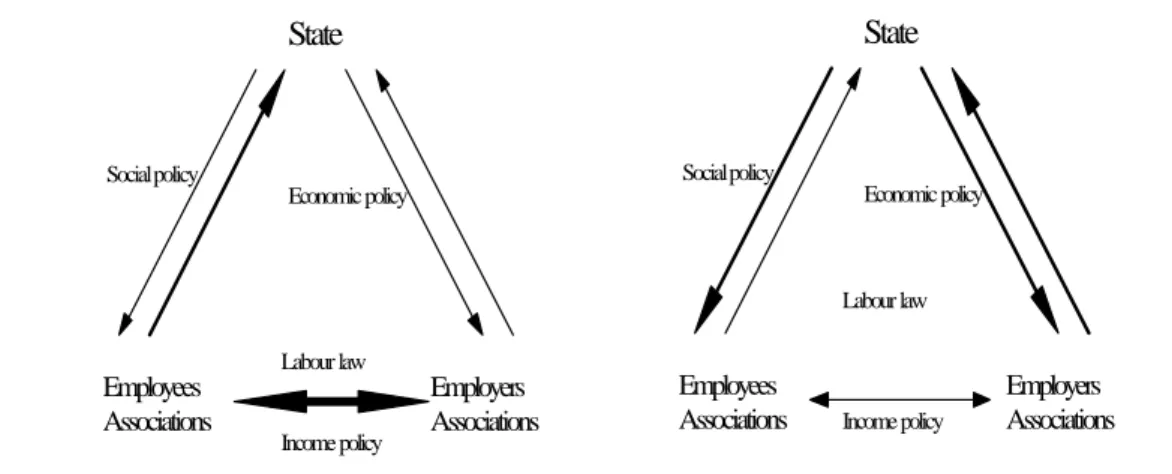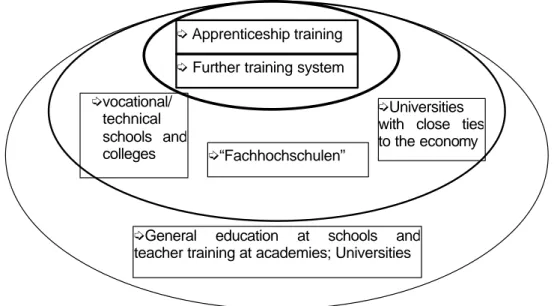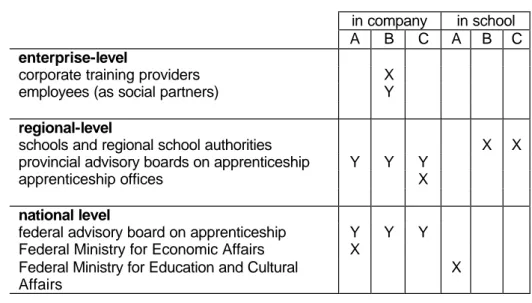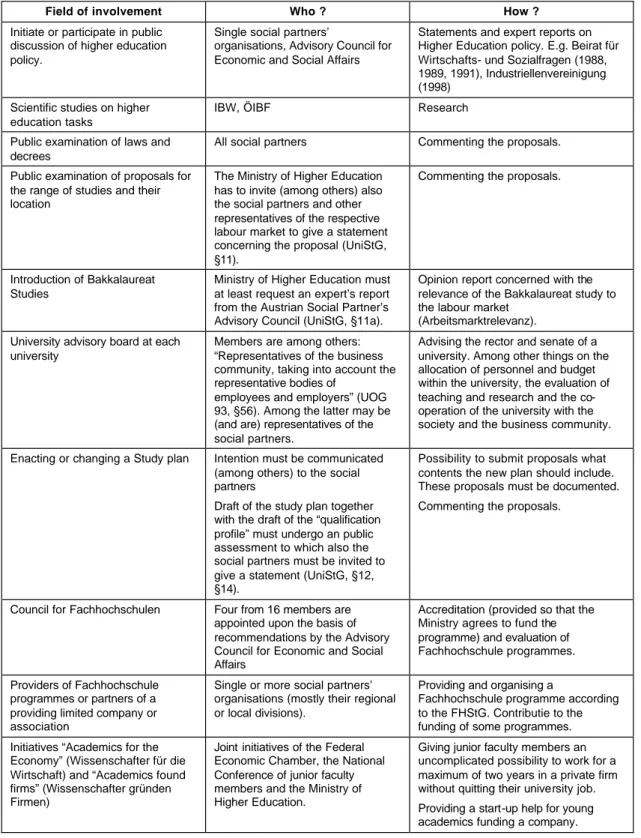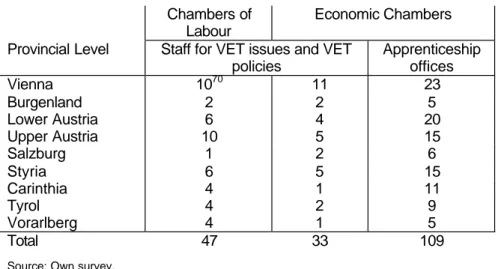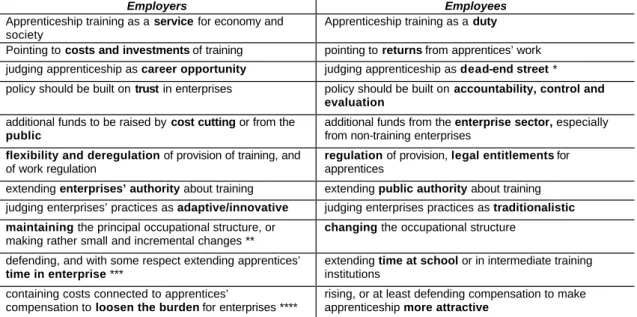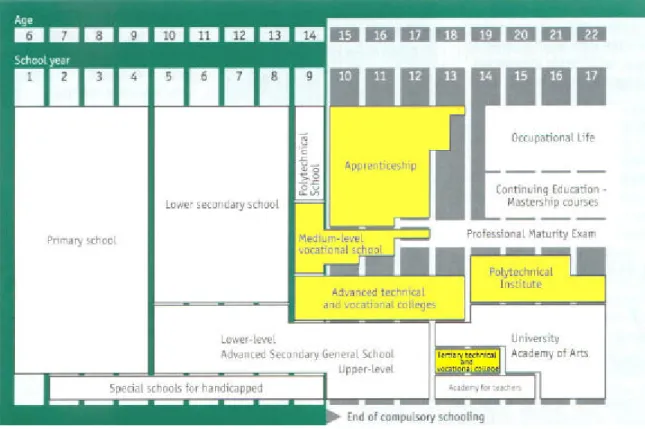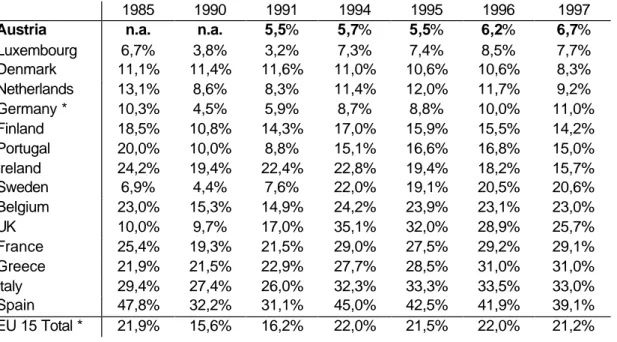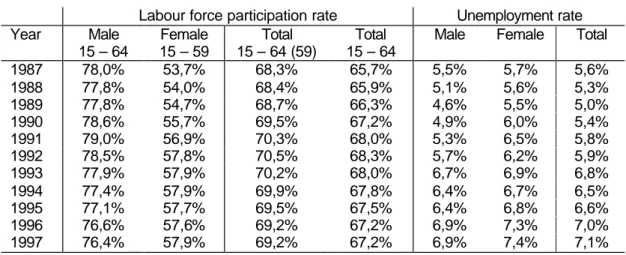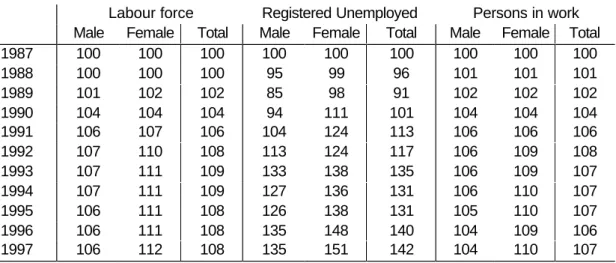Projektbericht / Research Report April 2000
Social Dialogue on Training Case Study Austria
Kurt Mayer, Lorenz Lassnigg, Martin Unger
Kurt Mayer, Lorenz Lassnigg, Martin Unger
Final Report
Commissioned by CEDEFOP
April 2000
Institut für Höhere Studien Stumpergasse 56, A-1060 Wien Fax: +43/1/599 91-191 Kurt Mayer
Phone: +43/1/599 91-135 e-mail: mayer@ihs.ac.at Lorenz Lassnigg Phone: +43/1/599 91-214 e-mail: lassnigg@ihs.ac.at Martin Unger
Phone: +43/1/599 91-133 e-mail: unger@ihs.ac.at
Institut für Höhere Studien (IHS), Wien
Institute for Advanced Studies, Vienna
This report was kindly assisted by B. Baumgartl, G. Fochler, and B. Seyr
Contents
1 Introduction ...1
2 Background Information on Economy, the Labour Market and Vocational Education and Training (VET) in Austria ...4
2.1 Economic background...4
2.2 The Austrian Labour market ...5
2.3 VET provision in Austria ...9
2.3.1 Legal and administrative foundations and political decision making ...16
3 The Social Partners’ involvement in the process of policy development: history and problem outline ...18
3.1 Actors, organisational and institutional set-ups of Social Partnership in Austria ...18
3.2 Austrian Social Partnership, its mode of function, its main fields of activity, and some recent challenges ...23
4 Social Dialogue on Training in Austria ...32
4.1 Social Partners and VET: a general overview ...34
4.2 Social Partners and the actor network of VET ...36
4.2.1 The Social Partners’ organisations in the field of apprenticeship training...36
4.2.2 Actors of Social Partnership in the field of CVT provision ...42
4.2.3 Social Partners in the field of labour market training and re-training...45
4.2.4 The Social Partners’ involvement in higher education policy ...45
4.2.5 Actors of Social Partnership in the field of VET research ...55
4.2.6 The Social Partners’ specialized staff on VET issues...57
4.3 Social dialogue on training: apprenticeship in the 1990s ...58
4.3.1 The main actors in the system and their policy strategies ...59
4.3.2 The policy initiative of 1997 ...63
4.3.3 Recent proposals and future perspectives ...66
5 Summary and Conclusions...69
6 Annexes and Bibliography ... 81
6.1 Economic and social committees with social partners participation... 81
6.1.1 Economic and social committees with social partners participation in the Higher Education System... 81
6.1.2 Economic and social committees with social partners participation in the School System ... 82
6.1.3 Economic and social committees with social partners participation in the Apprenticeship System ... 82
6.1.4 Economic and social committees with social partners participation in Labour Market Policies... 83
6.2 Statistical Annex and Tables ... 84
6.3 References ... 95
6.4 Abbreviations ... 107
6.5 List of Interviews and participants in the Focus group discussion ... 108
1 Introduction
Since the late 1970s salient and structural changes in the socio-economic environment and powerful economic forces (e.g. globalisation of markets, high speed technological innovation and ICT development) have been urging for upgrading and flexibilisation of VET-systems.
New equilibria have been looked for and developed between IVT and life long learning, between traditional occupations and flexible qualifications, between general education and VET, between curriculums based learning and qualification through work experience and between employment and self-employment. And all these relations and new equlibria have additionally been tied to the more principal and political core question concerning a new quilibrium between social demands and economic markets.
Evidently the institutional and organisational set-up administrating, influencing, developing and shaping the VET system and the actors and mechanisms of the social dialogue have not been untouched by the changes and challenges mentioned above. We were asked by CEDEFOP to specialize on the following issues and questions in the Austrian report on “A Social Dialogue on Training”:
– How are the trade unions and the employers’ associations – the social partners – involved in the VET system and in VET policy development?
– Are the roles of the social partners undergoing structural changes following the changes in the labour market specifically in society more generally?
– On the one hand, decentralisation of negotiations and agreements can be observed in most Member States while, on the other hand, agreement between the social partners at a European level are growing. What does this mean for the Austrian social partners’
involvement in VET?
– The development in most EU Member States goes towards increased market orientation of the provision of VET and a shift toward more social partner influence and/or enterprise responsibilities regarding VET with a corresponding relative decline in government involvement. What is the observation in Austria?
More specifically, our research was guided towards the following topics. It has to be said that
the questions concerning the changes of roles and influence of the social partners caused by
those structural changes are generally under-research. The report is compiling existing
knowledge, and has gained new knowledge concerning those topics, however certain
aspects have remained more or less open:
– The institutional and organisational set-ups as well as the loci, causes and mechanisms of social partners’ involvement in the social dialogue on VET.
– Factors contributing with the most explanatory power in the understanding of the VET development process.
– An assessment how the set-ups and mechanisms to be found can be evaluated with regards to the goal of developing sound and sustainable VET systems in a Europe of rapid economic and societal change.
Structure and content
Chapter 2 provides some background information concerning economic development, the labour market and the main assets of the VET (Vocational Education and Training) – System in Austria. Chapter 3 analyses the issues of the Austrian social dialogue on the general level of policy making, which poses the framework in that the social dialogue on training is embedded. Section 3.1. is analysing the basic set ups of the Austrian social partnership;
section 3.2. deals with the contribution of the social partners to the processes of policy shaping and policy development, a main focus being given to challenges for the social partners’ style of interest policies due to the changes in economy and policy since the beginning of the 1980s. Chapter 4 gives an overview regarding social partners’ involvement in VET (Section 4.1.) and is discussing in Section 4.2. the role of the social partners in the actor network of VET in a more detailed way, related to six main issues: 1) apprenticeship training, 2) Continuing Vocational Training, 3) Labour Market Training and Re-Training, 4) Higher Education Policy and, 5) the field of VET research 6) the vocational training issues departments. Chapter 4.3. looks at the social dialogue on training in the apprenticeship system during the 1990s. Problems deriving from the principal way of social partners’ policy involvement against the background of increased change are also mirrored in this case study. At least Chapter 5 draws the conclusions according to the main questions and tries to give some overall prospects with regard to the social partners shaping capacities on VET.
Methodological remarks
A mixture of methods was used to achieve the aims of the study:
1. Firstly a literature survey has been carried out aiming at pointing out the main features
with respect to the development of social partnership and social dialogue in Austria
especially since the beginning of the 1980s. The review of and selected elaboration on
findings from the major scientific and/or academic journals and other publications
provided additional background for the elaboration of tailor-made questionnaires for
key actors in the area social partners/VET. Furthermore it was a first step to make the
relations of VET in the context of social partnership visible.
2. The study will present main research dimensions in a time perspective in order to highlight developments and trends. Data concerning the size and power of social partners’ organisations has been collected – if possible – for the last 15 years.
3. A series of expert interviews were carried out with representatives of the social partners, their educational institutions, government officials, academics and other experts in the field (name, position and organisation of the interview partners you can find in the annex); as well you can find the questionnaire in the annex). Fresh information especially with respect to the changing features of social partnership mainly has been generated from those interviews.
4. A focus group discussion was held with participants from the social partners and academia in Vienna on 16 September 1999. The discussion focused on the verification/falsification of 11 statements and theses prepared by the project team.
5. A more detailed study is focused on the questions of functioning and sustainability of the training of apprentices in the Dual System.
6. Finally, a first draft of the report was revised on the basis of a round of critical comments by the social partners and a helpful review by an Austrian colleague.
It has to be said that the study, which is dealing with an eminent political topic, has been finalized during a period of serious changes in the Austrian political system, with several connotations for social partnership. The requested assessment of challenges to that system, and the presentation to an international public is to be seen as a sensible task. Moreover, it has to be taken into account that the available presentations about that topic have been often produced in a harmonized manner by some of the actors themselves. It has been agreed that the social partners’ organizations may add their statements to our report, in case that their view to some of the topics differs to our results.
Finally we have to thank all our interview partners, and the experts who participated in the
focus discussion. We have to thank the social partners’ organizations, especially Klaus
Schedler and Susanne Schoeberl, for their extensive involvement in the commenting
process, and Bernhard Kittel for the helpful comments in his review. Special thanks also to
Sven Age Westphalen from CEDEFOP for his kind support of our work and for his patience
in dealing with the prolonged process of review and discussion. Of course we as the authors
are responsible for the content, as it concerns the positive findings as well as possibly
remaining mistakes or misunderstandings of the complex issues.
2 Background Information on Economy, the Labour Market and Vocational Education and Training (VET) in Austria
2.1 Economic background
The economic development of post-war Austria can be characterised as a constant process of catching-up. Austria has overcome the evident war damages and now ranks among the highly developed welfare states of the Western world. Two figures will illustrate the process:
In 1954, Austria’s domestic gross product per capita (valued at 1990 prices in US dollars) was only 55% of the US-figure, but by 1995 it had already reached 90%. In the mid-1950s, Austria’s per capita national product (at current exchange rates) at 17% still lagged behind that of today’s EU-Members, but in 1996 Austria surpassed this figure by 24%.
1In the 1950s Austria established a trade of primary goods (steel, metal, basic chemicals, oil, paper) and tourism industries, focusing on the then rapidly growing West European markets in its immediate vicinity
2. The increasing internationalisation of the Austrian economy became evident as early as the 1960s. Foreign trade was the key to growth and employment, which made it more and more important for Austria to be competitive on the international market. Following the clear economic upswing after the wars, growth slowed down in the first half of the 1960s, which can be attributed partly to the structural adjustments necessitated by intensifying endeavours to open up the economy, and partly to the scarcity of labour.
3From the end of the 1960s until the mid-1970s, Austria benefited from the boom in industrialised countries in Western Europe and North America. When the shock of the first oil crisis hit, along with the associated slumping of global economy, huge structural problems arose in Austria.
In the period 1974 to 1982, Austria mainly kept its growing figures up by increasing public spending, resulting in burgeoning budget deficits, whereas Austria’s competitive position could not be improved any further in terms of technology or prices. While in the 1970s Austria’s industry grew distinctly faster than in the European OECD countries, its economy faltered in the early 1980s, due to both structural causes (the large portion of industry in primary goods) and the efficiency problems prevalent in the state industries. An industrial policy of maintaining employment levels prevailed. This saved jobs in the short term, but in the longer term it triggered a crisis of the state industry. It was only with the help of heavy
1 This overview mainly follows Pichelmann et al 1998; see also Pichelmann/Hofer 1999, Lassnigg/ Schneeberger 1997, OECD 1997, 1999, IHS 1999a, 1999b, WIFO/ IHS 1999.
2 Kramer 1997: “Struktur- und Standortpolitik”, Paper for the Zukunftsforum at the chancellor’s office, Vienna, cited after Pichelmann et al. 1998.
3 Walterskirchen 1991: “Unemployment and labour market flexibility: Austria”, ILO, Geneva, cited after Pichelmann et al. 1998.
budget subsidies that it could be kept from grounding. After several crises, the state industries were ultimately privatised.
At the end of the 1980s, the opening-up of Eastern Europe led to a renewed economic boom in Austria. On the one hand Austria benefited from German Reunification and, on the other, its geographic location allowed it to profit, more than anyone else from the integration of the Central and East European economies in the global economy. This notwithstanding, the cyclical problems in Germany, meaning the dollar, lira and pound, and the not-to-be-forgotten difficulties in adapting structures to the changing global economy have recently led to growth in the EU area below average.
Summing up, we can state that the Austrian economy has clearly succeeded in catching up.
This growth was driven by a continually opening-up of Austria’s economy
4and by a dynamic growth of foreign investment in Austria.
5This success was made possible by the high degree of political and social stability, predictable wage cost trends and the well-trained and motivated workforce.
For the last few years, Austrian economy has garnered market shares (including in the high- tech field), the prices of its exports have improved and direct investments have reached a higher degree of internationalisation. Furthermore, Austria has proved itself to be especially competitive in products with medium value-added intensity and on nearby markets. It is undisputed that Austria has become a high wage location though unit wage costs have deteriorated relative to those of its trade partners due to the appreciation of the Schilling and a remarkable growth in the productivity of Austrian industry. Therefore, Austria has improved its competitive position relative to its Western trade partners considerably.
One criticism that has to be made is that Austria’s exports are lacking in modern technologies. They focus on medium-range technologies in resource and labour-intensive segments. In part, this may be attributed to the below-average research and development activities. Other weak points are the concentration on neighbouring instead of global markets and the lack of innovative business clusters.
2.2 The Austrian Labour market
The present situation on the Austrian labour market is very good from an international point of view. Of all EU countries, only Luxembourg has a lower level of unemployment (seeTable 7, annex) and the level of unemployment among young people is even the lowest in the EU
4 Which led to a rapid increase in productivity through cost-cutting technological progress and to a change in the structure of the economy.
5 Austria was able to introduce and spread new business practices and modern technology mainly by attracting foreign investment and importing advanced capital goods.
(see Table 8 and Table 9, annex). But also with respect to employment, Austria ranks among the forerunners. The labour-force participation rate (measured in % of working-age population or in full-time equivalents) is around 70% (67% respective) and, thus, about 10 percent higher than the EU average (see Table 10, annex). However, the labour-force and the working population grew during the 1990s, so did unemployment in Austria – contrary to several other EU countries (see Table 11, annex). Only in 1999 a slight reversal of that trend occurred.
According to the national method of counting the unemployment rate
6in Austria increased from 5,6% ten years ago to 7,1% in 1997. The female unemployment rate was higher than that of men (up to 1,5 percent) but during the last years converged the two rates more and more so that the difference is today 0,5 percentage points (see Table 10, annex).
In general, the labour fore has grown since the 1960s, which is mainly due to the increase in the participation rates of women in their prime.
7However, the activity rate of young men has declined, due to longer periods of education, along with that of men over 55 years of age. In general the activity rate of older workers is much lower in Austria than in most other countries of the EU. The employment rate among 55-to 64-year-olds in Austria is almost 6 % and the activity rate in the 55-to 64-age group in Austria is almost 10% lower than the total figure of the EU. Consequently, the rate of unemployment in Austria in this age group was not even half as high as the EU average. Related to this observation is the fact that the average retirement age in Austria is rather low international the speaking. The average retirement age (excluding public servants) was 58 on average for men and 56,5 for women in 1996. Since the mid-1970s, the average retirement age has declined by roughly three years. The number of retirements is, to a certain extent, merely a reflection of the situation on the labour market for older workers and plays quite a significant role in relieving the pressure on the market. If the reduction in the labour force due to early retirement were mechanically translated into an increase in unemployment on a one-to-one basis, the latter would, indeed, have been almost 50% higher than it actually was in 1996.
8Nonetheless, it is meanwhile the generally accepted goal to move the actual age of retirement closer to the statutory retirement age, and a series of policy measures has therefore been implemented.
Over the last 30 years, roughly two thirds of total employment was represented by dependent employment in the private sector. This share has risen slightly during the last decade and now (1998) ranks at 68,9%. However, regarding government employment and self-employment, remarkable shifts have occurred since the 1960s: in 1998, the proportion of
6 National method: Registered unemployed per sum of dependent employed and unemployed persons.
EUROSTAT-method: A more narrow definition of unemployed persons per sum of total employment (including self-employment).
7 This trend can be attributed to the higher degree of education, the lower fertility rates and the changed role perception of the role of women in society.
8 However, this mechanical approach strongly overestimates the amelioration effect of early retirement in the medium and long terms. See Pichelmann et al 1996, on this issue.
self-employed persons sunk from a quarter in 1965 down to 11% mainly due to the shrinking number of farmers. However, employment within the public sphere rose from a share of 12%
of total employment in 1965 up to 20,8% in 1998 (with a peak of 22,5% in 1994–1996). With other words: A fifth of all employment in Austria is government employment and only every tenth person is self-employed (see Table 12, annex). Due to a phase of budgetary consolidation, employment in the government sector will shrink even further.
Regarding the Austrian labour market by sector, the most striking aspect is the still quite high proportion of the primary sector in Austria of about 8% of total employment in 1996. The secondary sector contributes, with 30% of total employment, more or less the same amount as in the EU average. However, the international trend towards the tertiary sector is also visible in Austria. Due to breaks in the series, only data from 1995 on are available on this, but even since then the share of the tertiary sector has risen by nearly 2 percent of all dependent employees in Austria (see Table 13, annex).
9The same picture can be observed in the structure of employment by industry: Nearly 21% of all dependent employees work in the production industry, another 9% in construction (more or less the secondary sector). 16% are employed in public administration, another 5% in health care and 4% in education (more or less the government sector). In the trading and retail industries, 16% are employed and in hotels and restaurants (the for Austria so important tourism industry) another 5% of all dependent employees work. Real estate and business services (with 7% of all employees) are growing quite fast, as well as other services, whereas the shares of industrial production and the primary sector among total dependent employment are shrinking further (see Table 14, annex).
Also evident is the segregation of the labour market by gender. In transport, construction, electricity/gas and water supply and mining the sectors, more than 80% of all dependent employees are male, whereas in health care, education, hotels and restaurants and in other services the proportion of women among all dependent employees is higher than 60%. The averages of all industries are 60% male versus 40% women.
However, the average growth in employment within the service sector is not represented by all professions. A recent forecast for the regional labour market of Vienna (Prenner et al 1999) shows a clear trend towards an increasing segregation by the level of qualification.
Highly qualified professions in the service sector did, and will, expand most, but also professions with a low level of initial qualification will grow slightly in the service and the production (construction) sectors. In comparison employment in professions that require a medium level of qualification did and will shrink. A division by sector, where the service sector is divided into primary (lower average qualifications required) and secondary services
9 Note: this table shows only the dependent employees and does therefore not include self-employed farmers which are responsible for the higher share of the primary sector in general.
(higher average qualifications required), shows these trends even more clearly (see Figure 4, Figure 5 and Figure 6, annex). The differentiation of the two segments of the service sector can also be described as the primary segment that uses very much the new information and communication technologies and the secondary segment that is not so directly involved in these developments. As far as the labour market is concerned, one of the main problems of parts of the primary segment (telecommunication, new media and EDP- businesses) is the lack of adequately qualified persons on the labour market. The number of open positions quite often exceeds the number of job seekers. This fact is regarded as one of the most important obstacles of further growth in these industries.
Very obvious is the trend towards a higher qualification level in employment if one differentiates the unemployment rate by initial education. The overall unemployment rate was – according to the national counting method – 7,2% in 1998. By comparison, the unemployment rate of higher education graduates was only 2,4% but the unemployment rate of graduates from compulsory schools amounts to 13,8% – nearly double as high as the overall average (see Table 15, annex). All other qualification levels are still below the average of the total unemployment rate, but apprentices are already reaching 6,5%.
Although apprenticeship (the so called dual system) slightly loses importance in favour of higher levels of qualification it still plays a very important role in vocational training in Austria and may therefore have contributed to the comparatively low rates of unemployment of youth (see above). In 1998 40% of all 15-year-olds attended the first year of an apprenticeship (see Table 16, annex). Between 1975 and 1990 this rate remained more or less constantly at 47% and decreased during the last decade due to structural changes in the economy. The participation rate among young men fell during the last 25 years by around 10 percentage points. However, the rate is still much higher for men (51%) than for women (29%). The balance of apprenticeship positions offered versus the demand for them fell quite dramatically from the beginning of the 1990s on, so that it has been negative since 1995.
This is, in general, recognised as a severe problem and policy measures have been intensified since 1996 to turn that development around (see Figure 7, annex).
Another point that is said to contribute to decreasing unemployment rates in other countries is the expansion of part-time employment. In Austria part-time employment plays a minor role compared to other European countries and reached a proportion of 15% of total employment in 1997. Only 4% of male workers are employed part-time and this figure did not vary significantly during the last decade. It is women that are mainly employed part-time, and their number is also increasing. In 1997 were nearly 30% of all working women in Austria part-time employed.
In summary the Austrian labour market, during the last decades, was in a more favourable
situation than the labour markets of other Western European countries. This is still the fact
even if unemployment rates in Austria have risen. One can diagnose an increasing
participation rate of women and a strong trend towards early retirement. The Austrian labour market came under pressure at the end of the 1970s as a consequence of the oil crisis, during the 1980s mainly as a consequence of productivity problems within the state owned industry, and recently as a consequence of growing internationalisation, competition and technological developments accompanied by pressures on the productivity (and therefore the wages) and an increasing mismatch between demanded and offered qualifications on the labour market. Austrian policies try to answer these problems with reforms that aim to bring (higher) education closer to industrial demands and with active labour market programmes, such as the National Action Plan for Employment (NAP) that focus especially on risk groups.
2.3 VET provision in Austria
The Austrian VET- system is described in great detail elsewhere (Piskaty et al. 1998), so we can focus on some of its crucial dimensions. The system can be broken down into the following basic components, which are more or less separate:
1. The initial VET-system (IVT-system, see Figure 3, annex) comprising the medium level vocational schools, the vocational and technical colleges, the apprenticeship system, the polytechnical institutes (“Fachhochschulen”) and the non-degree tertiary and technical colleges
10.
2. The system of continuing vocational education and training (CVT) provided by education and training institutions, comprising non-degree university courses, the training institutions run by the social partners, a variety of private CVT providers, the training and re-training measures initiated by the public employment service.
3. The widespread system of informal enterprise training, which predominantly takes the form of on-the-job activities and to some extent, is combined to formal activities in training institutions. This system is “invisble” in the sense that those measures are difficult to observe by the traditional information systems. Consequently, information even on such simple things as participation rates, or structures of supply is not easily available.
11
10 Referring to law FH study programmes aim at providing students with a ‘scientific based vocational training’
while universities aim at providing with ‘scientific career-preparatory education’ (wissenschaftliche Berufsvorbildung). Since the priority of university education lies on providing scientific qualifications they normally are not labelled as vocational institutions (see also Piskaty et al. 1998). However, in certain fields especially with respect to applied economic and technical study programmes at universities the difference to the
“Fachhochschulen”may be difficult to draw in practice.
11 Cf. WIFO/IHS 2000, EC-DG XXII 1998.
Considering their respective weights, and the relationships among those parts of the system, the highly formalised IVT-system clearly is the most developed one. The public education budget is mostly spent on the IVT-system. The following features, issues and frictions are characteristic of and crucial for the performance of the Austrian IVT-system.
– Compared to most EU and OECD countries the Austrian IVT-system is providing medium level vocational qualifications to a high proportion of the population. The proportion of the vocational tracks (apprenticeship, schools and colleges) at the upper secondary level of the initial education system is about 70% (OECD 1998).
Consequently more than 70% of the labour force have completed vocational education and training (including the comparatively low proportion of university graduates (OECD 1998, Piskaty et al. 1998, p.19).
– Austria exhibits a very favourable position concerning the widespread problem of youth unemployment. The measures are at the lowest levels in comparison to other countries, and the concerted action of the several involved players (government, parliament, social partners, AMS, schools, training enterprises) since 1996, which had been included into the NAP 1998, could so far manage to stop the increase of unemployment at the apprenticeship market, which had been especially severe among young women (Lassnigg 1999, Lassnigg/Schneeberger 1997).
– The participation of young people in IVT has gradually emerged during decades, therefore the qualification structure of the younger population is more advanced than that of the older population (among the 55 – 65 age group the proportion of people which have not completed a minimal vocational education is between 40% and 50%, among the cohorts below the age of 30 that proportion is about 20%), those disparities are more marked among women than among men, leaving a higher proportion of young women without vocational credentials until today (see Lassnigg/Paseka 1997, Prenner et al 2000).
– At the upper secondary level the Austrian IVT-system has both a strong apprenticeship sector (40% of young people at the 10
thyear of their educational career) and a strong system of vocational and technical schooling.
12The rise of the participation rate in education and training occurred subsequently in different parts of the system, during the period until the 1960s the apprenticeship system expanded markedly, during a following short period the academic track of general education took over the expansion, and since the 1970s the expansion has been mainly carried on by the technical and vocational colleges (WIFO/IHS 1998, p.85–91; Lassnigg 1997). The
12 That structure points to a marked difference to the well known German dual system, as well as to the Swiss apprenticeship system, as there existis a strong alternative to apprenticeship in Austria at the upper secondary level which brings about strong pressures for competition in terms of students’ educational choices as well as in terms of the recruiting behaviour of the enterprises.
latter are also estimated to grow further in the future (Lassnigg 1998b, Lassnigg/Nemeth 1999), a development that may lead in the longer term to a change in the leading position within IVT from apprenticeship to the TVCs.
– According to the marked expansion of educational participation the official statistics demonstrated that very few young people (1–3%) were out of education and training in the 10
thgrade, the share of young people leaving the educational system after the end of compulsory education (9
thgrade, at the age of 15) showing a decrease of about 10% points during the last two decades
13. However, the empirical basis of those statistics is increasingly doubted and alternative calculations point to a rate of about 8% drop outs at the end of compulsory schooling; the rate even pointing to a slight tendency to rise (Steiner/Lassnigg 2000, WIFO/IHS 2000). Among the 18 – 24 age group of young people who have left education and training, the proportion of persons having completed no more than the lower secondary level is about 12% (European indicator, WIFO/ IHS 2000, p.93), so there much is left to do to achieve the European target of that proportion reaching the zero-level.
– Piskaty et al. (1998, p.29) point to the historical legacy of “heterogeneity” within the Austrian education and training system, which has left remaining “separating factors”
within the “comprehensive” structure, both in “vertical” and “horizontal” terms. Within the IVT system several studies and comments have pointed to a rather stratified and specialized and also a highly regulated structure (CEDEFOP 1995, Brünner 1991)
14, that issue being one of the most severely contested terrains in the Austrian education and training policy field. The significance of that basic structure for today’s main challenges is rather clear in general terms
15– be it the structural matching to social demand as well as to manpower demand, or the mechanisms bringing about the flow dynamics within the system (including the foundation for life long learning attitudes and behaviour), or the potential of the system to develop the appropriate learning environments, or the outcomes of education and training pathways in terms of higher order skills and knowledge. However, in terms of more concrete policy design, not only the actions to be taken for meeting the challenges have remained much less clear, the ground for a thorough assessment is rather deep and swampy also. Consequently, the
13 Data from Lassnigg/ Schneeberger 1997, p.13.
14 A comprehensive analysis of the whole system including higher education some years ago (Lassnigg 1989, Lassnigg 1998b) observed a high number of study lines (65 in the advanced technical and vocational college, 110 in the medium-level vocational schools and 243 in the apprenticeship system. In sum, at the upper secondary level about 420 courses were estimated) showing the high degree of specialization within the the system. In the whole system, the tertiary level included, at least 670 different courses were counted, each of them regulated by detailed legal curricula. Broken down into subjects (about 15 per course), whose content is specified for each grade of the courses, the study found a very complex system of regulations. On the whole the regulations which indicate the content of the curricula may be estimated on a scale of at least a quarter of a million items, a degree of complexity which hardly allowed for keeping prospectus without the implementation of a developed system of knowledge management.
15 Cf. Nijhof/Brandsma 1999, OECD 1996.
appraisal of several basic assets of the system differs among political actors as well as among researchers, examples being the proposed solutions concerning specialization and flexibility, to the enduring barriers for permeability (opportunities for upward mobility) within the system.
– Despite several pronounced statements in favour for a strengthening of permeability since the 1970s, that aim has only been met to a limited degree until recently. The overall opportunities for access to more advanced educational pathways have expanded markedly on average; however, the mechanisms of social selection were not outpaced by that process, and mobility within in the upper secondary sector mostly remained to be downward flexibility,
16often combined with failure at school (most frequent transitions occur: Advanced technical and vocational colleges
17 ð Medium-level vocational schools
18 ð Apprenticeship19) Re-entering the schooling sector or higher education especially from apprenticeship is only possible at high costs, even if several policy measures and initiatives have been set for improvement during the 1990s (Piskaty et al. 1998, p.41–45) whose effects remain to be seen in the future. The apprenticeship system has been moved more closely towards the school sector by some of the changes which include a gradual introduction of general subjects, the pathways within the school sector have been made more flexible, and since 1997 the new opportunity of a “Vocational Matura” opens up a formal pathway into higher education from apprenticeship.
– The reforms, which have been amended at several aspects of the Austrian IVT-system during the 1990s, are bound to make its performance more flexible due to changes of the highly regulated and specialized basic structure. Since 1994 studies in the new institutional setting of the Fachhochschule are provided. The Fachhochschule framework rests on a completely different institutional setting as compared to the traditional structure of the Austrian IVT-system
20. In the course of steps towards more autonomy of the educational institutions the regulations of the technical and vocational schools concerning curricula, financing and students’ progression rules were gradually loosened. The degree of specialization was reduced in the IVT-schools. The regulation of higher education was broadly reformed towards more autonomy of the institutions, and tightening of the management structure including the establishment of more direct links to the economy and working life.
16 Lassnigg 1998b, Lassnigg 1997, also cited in Blumberger/Markowitsch et al. 1998.
17 With a drop out rate of at about 17% from the first to the second class (Steiner/ Lassnigg 2000).
18 With a drop out rate of at about 30% from the first to the second class (Steiner/ Lassnigg 2000).
19 Cf. Brandel et al 1994.
20 The FHS-framework is managed by a professional accreditation body, the regulation is bound towards outcomes and evaluation, the providers are given high autonomy in shaping their study supply, etc.
– Compared to other European countries the Austrian system does not provide open credit points, which the pupil can strive for and accumulate. It rather provides second- best alternatives in the case of failure within the area of first choice. Consequently the Austrian IVT-system is characterised by a low degree of modularisation, but by a high degree of segmentation.
– The occupational profiles are rather narrow from a general point of view. The overall degree of curricular specialisation decreases from apprenticeship to every higher level of education, which are even providing for more general education. And specialisation is higher in crafts engineering and production oriented study lines than in other sectors (administration, services). Especially the basic structure of apprenticeship occupations has been highly disputed since decades, resulting in some gradual steps towards more combined occupations (Gruppenlehrberufe).
– The formal certification system is almost comprehensive, with most of the credentials tied together in a framework of exchange relationships. The institutional structure bears a resemblance to the bureaucratic model.
Whereas both the public budgets and the political attention have been focused mainly on the
IVT system we can hardly speak of a system in the area of continuing vocational training
(CVT). The predominant and highly regulated IVT system is complemented by a CVT-sector,
which is mainly based on private activities, exhibiting salient structural weaknesses and
deficiencies. It has not been until recently that the development of a system comprising
further training, CVT and company development of human resources (HRD) would have
been a point of reference for policy debates and programmes in Austria. Ofner/Wimmer
(1998) give a comprehensive account of the policy debates concerning that sector which
shows rather deep cleavages among the involved actors, especially the role to be taken by
the state being highly contested. In terms of historical development, education for adults
emerged due to private initiatives, such as the religious communities, trade unions, the
forerunners of the chambers and political parties, at a time when the public sector expressed
no particular interest. Remarkably, those major social forces have largely retained their
predominance in adult education, the state rather taking a moderating role. In the course of
intensifying adult education during the 1960s, the parliament passed the Promotion of Adult
Education Act in 1973. In this federal law the funding of adult education and public libraries
from government budgets is regulated. Adult education deriving from this strand was mainly
related to general education, partly to “second chance” education within the formal education
sector, but normally not to vocational education and training. Furthermore this act does not
regulate any responsibilities and competencies for CVT, it just regulates the expense of few
public money for mainly general adult education. As a result the realm of continuing
vocational education and training can be characterised by a market model which is only
weakly embedded in a legal framework. This organisational mode of CVT in Austria causes
salient problems and respective criticism highlighting especially the point that markets need
bodies of co-ordination and regulation
21to enable effective competition and efficient supply (Chang 1997). This state of affairs was commented by the OECD with the remark: “Nobody really feels responsible for promoting and boosting CVT” (OECD 1995, p.85) and – following the argument of the OECD – in consequence, CVT particularly for engineers, technicians and managers who have acquired a few years of professional experience is still patchy, segmented, not well organised and without an overall response to current and foreseeable needs (OECD 1995, p.85). The Austrian CVT system exhibits the following features, issues and frictions.
– Based on the employment strategy a priority for the development of life long learning has been developed in the first Austrian NAP which gives a rather general outline for steps towards a policy strategy for life long learning.
– As in many other countries, there is a lack of clearly defined definitions and quality criteria. The issue of identification, assessment and recognition of informal qualifications is also observed as a new and unresolved one (Bjornavold 1999, p.2).
– The lack of information even on such simple things as participation rates, or structures of supply, has been somewhat alleviated by the information from the European labour force survey only recently. The figures point to participation rates next to the European average, and to a moderate prevalence of the well known disparities concerning access based on social traits as gender, education, age, occupation, etc. to CVT (O’Connell 1999). An easily accessible information system about CVT supply has been under construction for some time, those activities have been strengthened recently with assistance from the ESF. The existing information about funding of CVT is based on rather weak estimates so far, however, the figures show clearly the predominance of IVT in that respect (CEDEFOP-Panorama 1998). That issue has caused discussions about the further development of the financial relations among the sectors of the Austrian education and training system (Riemer 1999).
– Based on responsibilities for continuing professional development a small number of institutes mainly owned by the social partners are the dominating providers of CVT (Piskaty et al. 1998, p.58), especially WIFI and BFI, one belonging to the employers’
organisations and the other one to the employees’ organisations. The Austrian NAP considers those providers as the most competent ones, deserving further promotion on grounds of effectiveness and efficiency. As about two thirds of participation is already covered by those institutions, the market seems monopolized to a certain degree
21 Regulation in this respect means not to strengthen the density of bills and ordinances. It is rather directed towards government activity that is intended to affect directly the behaviours of private sector agents in order to align them with the ‘public interest’ without operating as a public enterprise. Consequently regulation is directed towards an effective framework of the market and towards effective incentives to increase participation in the market.
(WIFO/IHS 2000, OECD 1997), that figure posing at least some puzzles to the strong rhetoric of market.
– The Public Employment Services (AMS), which is providing training measures as a main domain of active labour market policy, is the big customer on the CVT market.
Labour market training is the main public source for continuing education and training, the CVT providers having to tender for that sources.
22As the social partners are involved in the supervisory boards of the AMS at national, regional and local levels (see also chapter 4.2.3) that structure implies at least indirect ties between their further training institutes as suppliers on the CVT market and the AMS as a customer on this market
23.
– Apart from those networks, the CVT market has evolved strongly during the last decade, and there is high competition
24among many other market providers, some observers also pointing to rising prices on that market. A lack of market transparency for the customers is widely seen as a deficiency. This scarcity of market transparency might lead to an imbalance and as a consequence to uncertainty and a reduction of investments (Kramarsch 1995, p.9/10)
– A low degree of professionalization is highlighted by some analysts (Lenz 1997, Ofner/Wimmer 1998) that issue being taken up by the Austrian NAP in projecting the promotion of full time employment in the adult education sector.
– The prevailing weak co-ordination of public activities (the involved federal departments are acting virtually without co-ordination) due to the lacking overall framework is addressed to some extend by the Austrian NAP.
22 There are some differences concerning the funding structure of the institutes, the BFI raising a higher proportion of its funding from labour market policy, see chapter 4.2.3.
23 In the analyses of the OECD this issue is formulated even more pointed: “Overall, the market for providing training services is not very competitive: local markets for adult training are dominated by a few big providers (the unions and the employers’ federation). Moreover, the same organisations are also represented on the decision making boards of the labour office which, in addtition to contracting out training, also provide the investment capital for many centres. Although this might facilitate efficient planning of training programmes, there is nevertheless a risk of conflict of interest as the social partners are involved in funding decisions affecting their own training facilities. In addition, the development of effective competition might remain restricted” (OECD 1997, p.147f.). See also OECD 1995, p.25.
24 Despite the organisational ties between the AMS and the social partners the social partner’s institutes are involved in the market competition since the AMS of course has to do an invitation to tender; moreover in each federal counrtry the AMS has between 40 and 100 partners.
2.3.1 Legal and administrative foundations and political decision making
25The main legal basis of the school-based sectors of education, but excluding universities and other higher education colleges, is the Austrian education law, which consists of different acts, like the Organisation of Schooling Act or the School Instruction Act. For universities and other higher education colleges, the corresponding acts are the University Organisation Act (1993) and the University Studies Study Act (1997). The Fachhochschule Studies Act of 1993 established the prerequisites and the procedures for the recognition of Fachhochschule programmes as well as the conditions of awarding the institutional designation
“Fachhochschule.” Given the major importance of apprentice training within the initial vocational training sector, the sixth main legal pillar of the Austrian education and training system is the Vocational Training Act.
26As already mentioned above, the legal foundation of adult training can be found in the Adult Education Act of 1973 (see also above). Training and re-training in the responsibility of the Public Employment Service is based on the Labour Market Promotion Act of 1969.
All these legal regimes have one thing in common: starting at the highest level of Austria’s federal structure, each of them defines areas of autonomy and devolved competencies for each of the lower levels. Where competence is devolved, the subordinate level is accountable to the superior level, whereas where the competence is autonomous, each level can act independently and is responsible only to itself. Another typical feature of the education and training administration is the existence of collegiate bodies at various levels, which, wherever possible, bring together as full voting members representatives of all the social forces relevant to the field of policy-making.
The two main policy-making institutions in the field of education and training, which together form the Federal Parliament, are the National Assembly, which is the more important chamber in this bi-cameral system, and the Federal Assembly, which represents the federal provinces. Draft legislation is usually submitted to Parliament by the Federal Government on the basis of a unanimous vote. A two-thirds majority in the National Assembly is required for passing legislation on matters concerning the organisation of education.
Before the submission to the Federal Parliament, draft legislation and draft regulations are commented on by the federal ministries concerned, the provincial governments, and to the extent to which their field of competence, is concerned relevant by statutory special interest bodies. Also consulted in this procedure are relevant non-statutory special interest associations, in particular those representing the interests of employers and employees. In the matters concerning education, the consultation procedure as well involves teachers’
25 The following section heavily draws on: KulturKontakt 1996, p.129f; cf. also Piskaty et al. 1998.
26 The complexity of the regulation of the apprenticeship system is underlined by the fact that the law concerning Employment Protection of Young People and the basic economic regulation (Gewerbeordnung) also include important issues for that system.
associations and the apex organisations of parents’ associations, youth associations, other
educational bodies, the most important religious associations and other groups.
3 The Social Partners’ involvement in the process of policy development: history and problem outline
We firstly describe the actors, the organisational and institutional set-ups of social partnership in Austria. Secondly we give a short outline regarding the mode of function and the main fields of activity of the Austrian Social Partnership in the post-war period. In this part we also will consider the changes in the involvement of social partners in the process of policy development in the 1980s and 1990s.
3.1 Actors, organisational and institutional set-ups of Social Partnership in Austria
27The term social partnership embraces quite wide ranging forms of collaboration between employers and employees or the associations and interest groups representing them. In Austria this collaboration is particularly pronounced and can be regarded as a decisive element of the political system (KulturKontakt 1996, p.127). Co-operation between the social partners and their influence on politics has become institutionalised to a greater extent than in virtually any other democratic state. It can be stated that with respect to the economic policy, labour market policy and social policy Austria represents a corporatist model of interest intermediation
28. Apart from the state the main actors in this model are:
– The Federation of Austrian Trade Unions (Österreichischer Gewerkschaftsbund, ÖGB);
– The Austrian Federal Chamber of Labour (Bundesarbeitskammer, BAK);
– The Federal Economic Chamber (Wirtschaftskammer Österreich, WKÖ);
– The Chambers of Agriculture and Forestry (Landwirtschaftskammern);
– The Federation of Austrian Industry (Industriellenvereinigung, VÖI).
The Federation of Austrian Trade Unions and the Austrian Federal Chamber of Labour are representing the employees. The Federal Economic Chamber, the Federation of Austrian Industry and the Chambers of Agriculture and Forestry are representing businesses and those independently employed on the land.
While the membership in the Federation of Austrian Trade Unions and also in the Federation of Austrian Industry is voluntary, the chambers are public corporations installed by law, have compulsory membership and have the right to comment on government proposals before
27 The following section on actors in the Austrian social partnership draws on Pichelmann/Hofer 1999, p.44–47 and on KulturKontakt 1996, p.127f.
28 This model has some specifities being unique to the Austrian economy. Following an OECD analysis “on both sides of the labour market, there exists a parallel set of voluntary organisations (trade unions, industrial associations etc.) and self-governing incorporated bodies called chambers (Kammer) ….The chambers on each side of the labour market are hierarchically organised with two central chambers for, respectively, workers and employers. In addition farmers have a separate chamber” (OECD 1997, p.128).
these are forwarded to parliament (Kittel 2000). Consequently the financial resources of the chambers are legally guaranteed by means of compulsory dues. As statutory corporations the chambers are entitled to represent their members’ interests intensively, internally they rest on democratic representation and include extensive mechanisms of interest intermediation among the various subgroups. Their sphere of influence includes the self- governance of the social security system, formal involvement in social and economic legislation, representation in an immense number of tripartite advisory boards (Karlhofer 1996, p.121f.) We will give a short description of these organisations in the following.
The Federation of Austrian Trade Unions (ÖGB) differs from most trade union organisations in other democratic countries in that it is non-party and highly centralised. Its main tasks consist of the representation of the social as well as of the economic interests of its members and of employees in general in their working life. Different political directions are represented by individual sections within the organisation, the biggest being the social-democratic section. The Federation of Austrian Trade Unions is more than just an umbrella organisation like Germany’s DGB or England’s TUC. It was founded before the individual trade unions and it is still the main body representing workers retaining power of the purse and personnel over the specific trade unions to this day. Referring to the organisational set-up the ÖGB combines a differentiation into initially sixteen (today fourteen) trade unions.
The Austrian Chamber of Labour is the statutory interest group organisation of dependent employees with compulsory membership. Particularly important among their duties is the participation in all measures and organizations, which affect employment or the economic and social situation of blue and white collar workers (KulturKontakt 1996, p.128) Chambers of Labour are constructed in all nine Federal Laender of Austria. Members are fundamentally all employees except public servants and white collar workers belonging to the management.
The Austrian Chamber of Labour is working close to the Federation of Austrian Trade Unions, leaving the responsibility for collective bargaining with the ÖGB,
29and performing among its several functions also as an important intelligence staff unit. It employs a large number of specialists capable of playing a decisive role in economic and social policy.
The Austrian Federal Economic Chamber is as the statutory interest association of employers based as well on compulsory membership and appointed to defend the common interests of all independent entrepreneurs. Like the Chambers of Labour also the economic chambers are constructed in all nine Federal Laender of Austria. The organization of the Chambers of the economy is formed in all nine Federal Laender of Austria by a range of highly differentiated organizations to represent the different branches of the economy (business and trades, industry, commerce, finance, tourism, credit and insurance). As well as the Chamber of Labour the Federal Economic Chamber employs a large number of
29 The development of the relations among the employees’ organizations are analyzed more detailed in Klenner/Pellar 1999.
specialists capable of playing a decisive role in the economic and social policy discussion.
Due to the structure of Austrian enterprises, small and medium-size businesses dominate the Federal Economic Chamber.
The Federation of Austrian Industry comprises the rather large industrial enterprises but as well companies from the services and many SMEs. Membership in this group is voluntary.
Even if this association is not a formal part of the Austrian social partnership
30in order to do justice to the often divergent interests held by trade and industry, a representative of the Federation of Austrian Industry is always included on the employer’s negotiating team in social partnership negotiations. And the Federation of Austrian Industry especially is involved in the formation of new innovative regional production and learning networks (e.g. the automotive cluster Styria).
The Chambers of Agriculture and Forestry represent the interests of those independently employed on the land. They exist only at provincial level but there is central representation however at the Presidential Conference of Chambers of Agriculture and Forestry.
The Parity Commission
The Parity Commission forms the core organisation of the economic and social partnership.
The Parity Commission consists of four sub-committees:
– The Sub-Committee for Prices (since 1957) – The Sub-Committee for Wages (since 1957)
– The Advisory Board for Economic and Social Affairs (since 1963) – The Sub-Committee for International Issues (since 1992)
Since the Parity Commission has no legal foundation, its basis consists of a non-binding understanding between the parties, according to a form of gentlemen’s agreement. This commission works under the chairmanship of the Federal Chancellor and with the participation of relevant Federal Ministers, but only the four main interest groups are entitled to vote.
– The Federation of Austrian Trade Unions (Österreichischer Gewerkschaftsbund, ÖGB);
– The Austrian Federal Chamber of Labour (Bundesarbeitskammer, BAK);
– The Federal Economic Chamber (Wirtschaftskammer Österreich, WKÖ);
– The Chambers of Agriculture and Forestry (Landwirtschaftskammern);
30 There is some debate among experts if the Federation of Austrian Industry should be counted as a ‘social partner’. Arguing with their account about its anti – union or even anti – social-partnership orientation Kittel/
Tálos (1999) would hesitate to do this. Nevertheless the Federation of Austrian Industry plays an important role especially on the political or ‘macro’ layer of interest intermediation towards which this rather general chapter is directed. Since the main European interest organizations do not accept statutory membership the Federation plays an important role at the European level (Falkner 1999, p.229).
The Commission’s decisions must be approved unanimously, consequently reinforcing the process of compromise. This commission never had any recourse to direct legal sanction possibilities, it rather expects that those associations concerned with it will maintain a conciliatory attitude by virtue of the authority of their members. However in the 1990s the Parity Commission has lost its coordinating function and currently only serves as a discussion forum between the interest associations and government (Kittel / Tálos 1999). Of the two traditional subcommittees (prices and wages), only the wage commission still functions in that it formally has to consent to bargaining over collective agreements. Price regulation is practically irrelevant. On the other hand since internationalisation has increasingly become a challenge for national economic policy in 1992 a new sub – committee for international issues has been established. In the course of Austria’s entry to the EU and the opening of the Eastern market the primary task of this sub – committee has become to evaluate the current international process and to submit expertise and proposals to the Parity Commission (Karlhofer 1996, p.126).
To make the process of collective bargaining and overall decision-making in the broader field of economic and social policies work, the Advisory Council for Economic and Social Affairs (Beirat für Wirtschafts- und Sozialfragen) is playing a major role. Since 1963 the Council as a kind of joint ‘brain trust’ of employees’ side and employers’ side has been responsible for carrying out research on social and economic policy issues. To accomplish this, the board calls upon specialists from research institutes and universities. The board’s aim is to arrive at a consensus on the perception of economic and policy issues. Both sides accept the recommendations of the studies as correct data resulting in a binding interpretation. Since in the 1990s the government has taken a more active role in policy formation in socio-economic issues the Advisory Council could even increase its position within the Parity Commission.
The Council developed to a significant consultant of the government but is also a forum for interest intermediation in terms of establishing a common understanding of problems and issues, which is laid down in joint reports.
31The Social Partners’ responsibility for the wide field of economic and social policy
The original aim of the Parity Commission was above all to keep inflationary price and wage developments in check. Later in addition to income policy, the social partners were increasingly incorporated in the economic and social policy decision-making process. It was not only accepted, but also often explicitly requested that decisions be taken by the social partners and then passed along the responsible state bodies – parliament and government – for the corresponding resolutions to be passed after further discussion and concretisation.
31 The Council (Beirat für Wirtschafts-, und Sozialfragen) has produced about three studies per year, including periodic mid-term projections of the public budget, more recent topics have been for example:
Wirtschaftspolitische Handlungsspielräume (Room for Manoevring in Economic Policy, 1998);
Beschäftigungspolitik (Employment Policy, 1997); Europäische Wirtschafts-, und Währungsunion – Neue Rahmenbedingungen für die österreichische Wirtschafts-, und Finanzpolitik (New Conditions based on the European Monetary Union, 1994), Wirtschaftsstandort Österreich (Austria as a Business Location, 1994).
